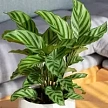
Calathea
Always green
| Latin name | Calathea |
| Homeland | South America |
| Family | Marantaceae |
| Cultivation | medium difficulty |
| Location | shadow |
| Temperature | 10-25 °C |
| Watering | moisten the soil and spray the leaves |
| Flowering time | depending on the species |
| Height | 30-70 cm |
| Transplanting | annually in spring |
| Appearance maintenance | remove damaged leaves |
Calathea is often confused with the genus Maranta. Calathea is still called this way, although botanically this name refers only to the white-leaved maranta (Maranta leuconeura), the only very common species of this genus. The genus Calathea includes 150 species, of which all the best - known are of Brazilian origin. These are delicate perennial herbaceous plants, loved for the beauty of sometimes very developed long-stemmed variegated leaves. Calathea Mackoyana (Calathea mackoyana) - the most common species, which with the hope of success can be grown in rooms. It is characterized by broad, blunted leaves of a bluish hue, veins and alternating small and large dark spots on the leaf plate; the leaf border is green. Calathea rosea-picta has oval blunted green leaves with pink or cream stripes along the central vein and above; the reverse side is red-purple. Calathea lanceolata (C. lancifolia) has erect linear-lanceolate wavy light yellowish-green leaves; often the central vein is darker, as are the edges. The leaf blades are covered with elliptical alternating large and small dark green spots; the underside of the leaves is bright red-brown.
Calathea is often confused with the genus Maranta. Calathea is still called this way, although botanically this name refers only to the white-leaved maranta (Maranta leuconeura), the only very common species of this genus. The genus Calathea includes 150 species, of which all the best - known are of Brazilian origin. These are delicate perennial herbaceous plants, loved for the beauty of sometimes very developed long-stemmed variegated leaves.
Calathea Mackoyana (Calathea mackoyana) - the most common species, which with the hope of success can be grown in rooms. It is characterized by broad, blunted leaves of a bluish hue, veins and alternating small and large dark spots on the leaf plate; the leaf border is green.
Calathea rosea-picta has oval blunted green leaves with pink or cream stripes along the central vein and above; the reverse side is red-purple.
Calathea lanceolata (C. lancifolia) has erect linear-lanceolate wavy light yellowish-green leaves; often the central vein is darker, as are the edges. The leaf blades are covered with elliptical alternating large and small dark green spots; the underside of the leaves is bright red-brown.
Cultivation
It is difficult to find optimal conditions for this plant, which requires very high humidity. In the room, it is necessary to create a microclimate by placing pots in containers filled with moist sphagnum. In summer, top dressing is mandatory - 20 g of full mineral fertilizer of prolonged action per bucket of water. Once a week, liquid fertilizer is added to the irrigation water to promote active plant growth.
Location
It is necessary to shade from the bright rays of the sun.
Temperature
Temperature conditions: from 10 °C in winter to 25° C or more in summer.
Watering
In addition to actively soaking the soil, it is necessary to frequently spray the leaves, which, in turn, should be cleaned of dust and dirt with a damp sponge. In autumn and winter, watering is noticeably reduced.
Transplant
Transplanted annually in the spring, because this plant produces substances that may be harmful to itself. Soil-slightly acidic from coarse peat, sod land and sand with the addition of pieces of charcoal.
Reproduction
Reproduction is carried out in the spring period by dividing the rhizome into parts - with leaves (preferably more of them) and well-developed roots. Each part should have at least 2-3 leaves and healthy, well-developed roots.
Diseases
Due to increased soil moisture, rot may appear on the roots, provoked by rhizoctoniosis (Rhizoctonia). On the leaves, spots are formed - a lesion of phylosticta (Phylosticta). In such cases, treat the plants with appropriate fungicides. Pests such as aphids, worms, and ticks are eliminated, respectively, by using anti-aphid drugs, anti-coccidal agents, and acaricides.
Acquisition
These plants are available all year round in horticultural centers that offer a wide range of crops. It is necessary to carefully check the leaves: they must be solid, free of stains, damages, deformations and other defects.